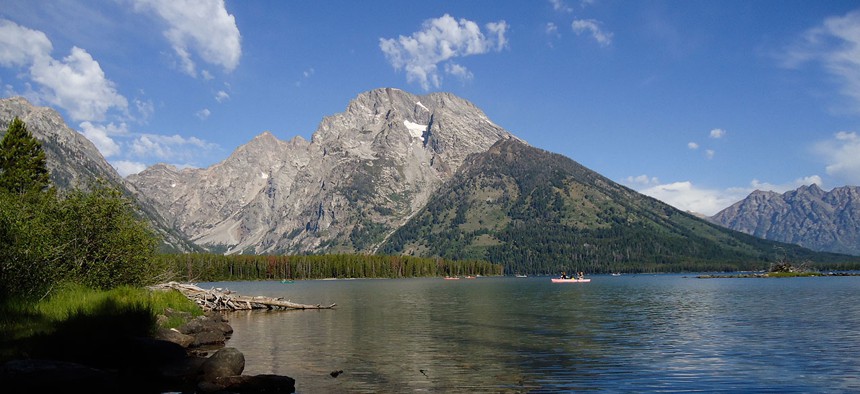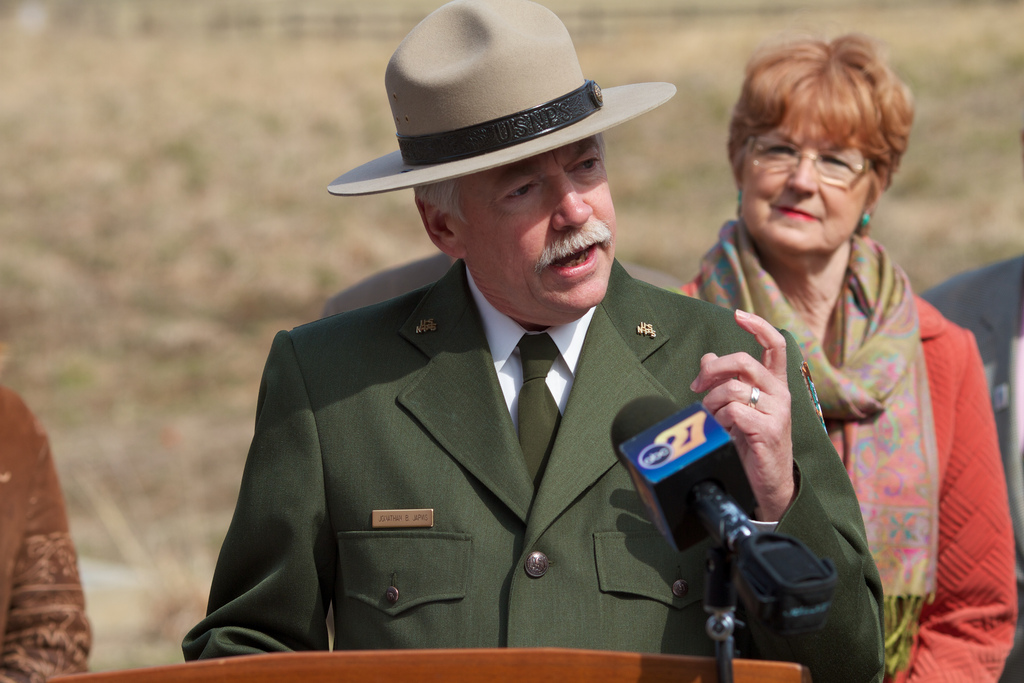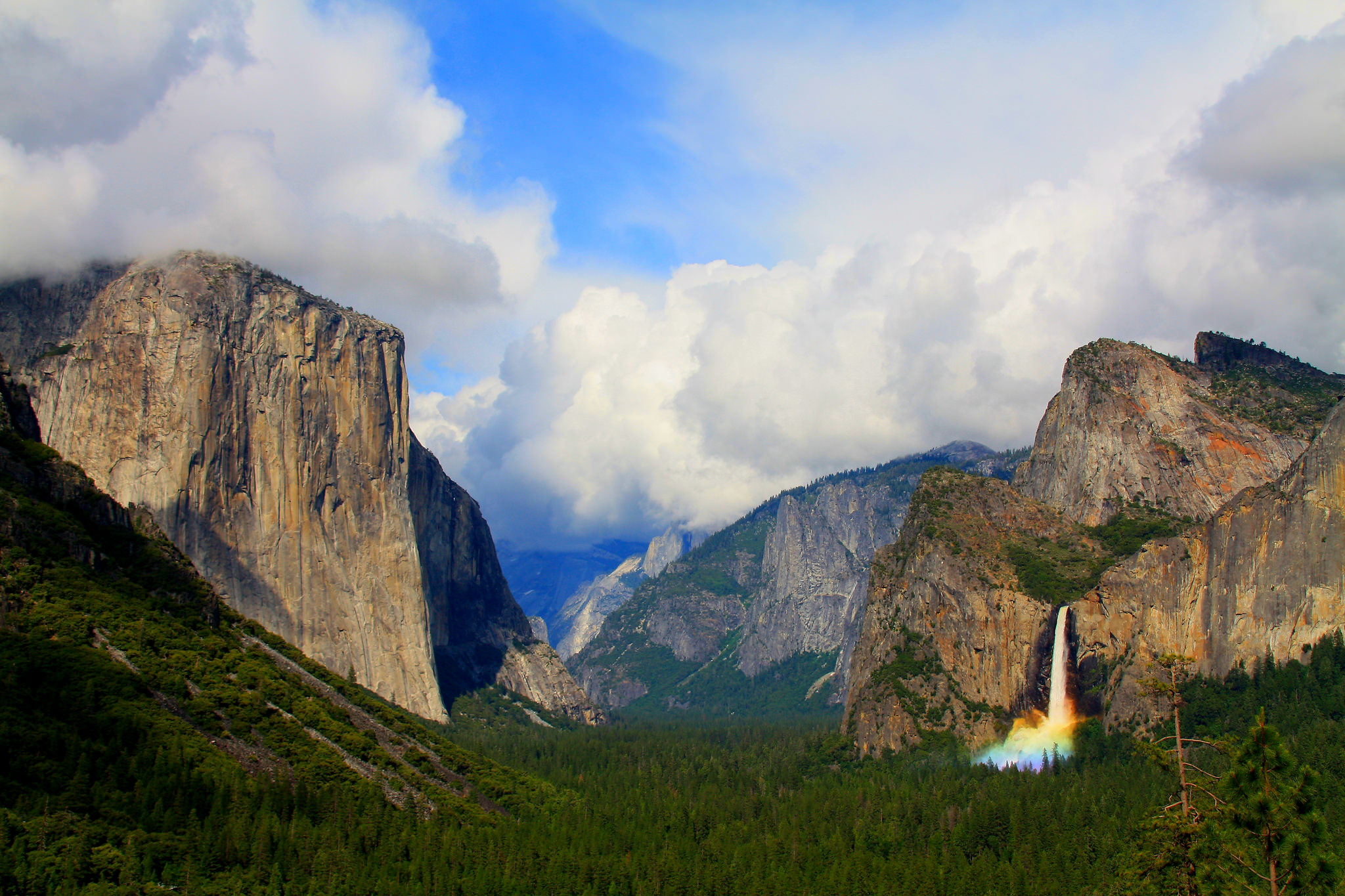
Campers canoe in the distance in Grand Tetons National Park. Donna Studniarz/National Park Service
Ensuring America’s Iconic National Parks Survive the Next 100 Years
In its centennial year, the Parks Service celebrates its legacy, while grappling with issues ranging from maintenance backlogs to trademark battles.
Jonathan Jarvis has donned National Park Service garb for 40 years. So the agency’s 18th director feels entitled to a few opinions on how to modernize its operations during its 100th anniversary year.
The National Park Service, signed into existence by President Woodrow Wilson on Aug. 25, 1916, is at a “pivot point,” Jarvis told Government Executive in an interview at his temporary office in the Interior Department’s Stewart Lee Udall Building in Washington. (The New Deal-era facility that houses his permanent office is undergoing renovations).
A host of celebratory public events are planned, something Jarvis said he hopes will move his 22,000 employees to “connect with and create the next generation of park visitors, supporters and advocates.” Laid out in a document titled “A Call to Action,” the centennial has been five years in the planning, Jarvis said, though its roots go even further back, to Interior Secretary Dirk Kempthorne during the George W. Bush administration.
The Call to Action describes hundreds of educational tasks and projects around the country. “It’s great to celebrate what does exist, and we need that base of support,” Jarvis said. But he also wants to deploy tools “to get out in front of what may have been forgotten, and introduce it to people who don’t know, and connect the next generation.”
Budget Recovery
The past decade has not been easy on the Park Service. Its annual budget—which goes to maintain more than 400 parks that attract 280 million visitors annually — now stands at $3 billion, but was as low as $2.6 billion as recently as fiscal 2015. The agency’s full-time staff dipped to 19,500 employees in fiscal 2015 before rebounding this year.
The centennial seemed to put Congress in a more generous mood. “In fiscal 2016, we got the largest budget in NPS history,” Jarvis said. That boost restored funding that had eroded, he said. The Park Service’s fiscal 2017 request of $3.1 billion would boost program and operational funding by another $250.2 million.

To plan and execute centennial celebrations, NPS will rely heavily on a seasonal workforce of 8,000-10,000 people, Jarvis said. They include rangers, front desk employees, search and rescue staff, firefighters, those who give interpretive talks, and law enforcement officers. The recent funding boost has restored seasonal staffing to traditional levels.
The anniversary funding includes a $15 million matching fund challenge—an extension of a program in which the Park Service leverages appropriated funds to win matching grants from non-government organizations. It covers everything from construction of facilities to youth and education programs. Another $90 million will go to physical infrastructure and $8.5 million for grants under the service’s From Civil War to Civil Rights initiative, Jarvis said. And $12 million is earmarked for urban parks in impoverished areas where green space is scarce.
In addition to its funding stream for operations, NPS has a separate repair budget, which it deploys in an effort to address a maintenance backlog of nearly $12 billion.
The Park Service maintains a transportation network that includes 5,500 miles of paved roads, 4,000 miles of unpaved roads, and more than 1,000 bridges—many of which are in mountainous areas or environments prone to flooding. Last year, the Park Service got the grim news that Federal Highway Administration inspectors had determined that Washington’s Memorial Bridge, which connects the NPS-curated Arlington House on the Virginia side of the Potomac with the NPS-managed Lincoln Memorial in the District of Columbia, has greatly deteriorated. It will require $250 million in repairs. That would almost eat up the entire $268 million the Park Service won in last fall’s five-year highway bill, Jarvis said.
The Park Service also has non-transportation maintenance costs for buildings, trails, restrooms, water supply and wastewater systems, maintenance sheds and housing for rangers. That category “has a $5 billion backlog on an annual basis and gets about half of what is needed just to keep even,” Jarvis lamented. “It’s on a constant decline.”
Shutdown Tensions
During the dramatic budget stalemate in the fall of 2013, Jarvis was frequently in the news. (He keeps a list of articles related to the drama that totals 35,000.) The appropriations lapse that forced thousands of federal employees to stay home also meant the Park Service sealed off the war memorials on Washington’s National Mall from tourist traffic. That displeased Republicans in Congress—whom many in polls blamed for the shutdown. Those lawmakers argued that Jarvis shouldn’t deny entrance to such sites as the World War II Memorial to elderly veterans who may have traveled long distances for a one-time opportunity.
“I came out a little roughed up,” he said, recalling a particularly contentious Capitol Hill hearing. “But the premise here is that we’re an operational agency, not a grant maker. So we can’t just stop. Like the military, we’re on the ground, with law enforcement, maintenance, emergency medical services teams, and our rangers as our eyes and ears. It’s for protection of the icons of America 24 hours a day.”
When Congress shuts off funding, all but about 3,000 Park Service employees must be furloughed, Jarvis said. “But we do have a responsibility to protect, and the way is to not let anyone go in. It’s not an easy decision, but the right decision. I take full responsibility.” There have been well-publicized incidents at Park Service properties, he noted. In 2013, a vandal threw paint on the Lincoln Memorial and a former Boy Scout leader tipped over an ancient rock in Utah’s Goblin Valley State Park.
Jarvis is “a passionate defender, a champion of park protection,” said Theresa Pierno, CEO of the nonprofit National Parks Conservation Association. She lauded him for helping the Interior Department shut down an oyster farm at Drakes Estero in Marin County, California, and for opposing a utility company plan considered by the Army Corps of Engineers to erect a transmission tower near the original Jamestown colony settlement site in Virginia. “It’s not always easy going up against another agency,” Pierno said. “At times he’s been aggressive when we needed him.”
Jarvis began his NPS career as a seasonal interpreter in 1976, and moved up to become a ranger, resource management specialist, park biologist and regional director before taking the agency’s top job. Appointed in 2009, he is likely to leave at the end of President Obama’s term.
Management and Funding Challenges
Jarvis’ tenure has not been without controversy. Last month, he was disciplined by the deputy Interior secretary after an inspector general’s report found he had skirted ethics rules by authoring a privately published book celebrating national parks—though he did not profit.
Also earlier this year, it emerged that a contractor, Delaware North, had trademarked several images and names related to Yosemite National Park, and sued to protect them after it lost out on a contract to continue to provide concessions at the park. The Park Service decided to change some of the park’s iconic names while the legal battle plays out.

Dealing with private concessionaires comes with the territory for NPS managers. “Food and beverage services, lodging, gift sales, guides and outfitters are all obtained through an open-bid process,” Jarvis said. “We create a request for proposal, and the winner pays a franchise fee for the privilege, typically a 10 to 15 year contract. There’s nothing like it anywhere in the world—a totally unique American enterprise.” But he admitted the arrangement creates “certain complications.”
At the Grand Canyon, for example, a contractor, Xanterra, built up credits with the agency for many years worth of improvements to buildings. When it came time to rebid the contract, it turned out the winner would have to pay the company $150 million, which “made the contract uncompetitive,” Jarvis said. He had to divert funds from other parks’ fee proceeds to pay off the accumulated debt.
The parks also depend on philanthropy. Usually, it comes via the National Parks Foundation. But there are exceptions. In January 2012, for example, billionaire David Rubenstein donated millions of dollars to refurbish the earthquake-damaged Washington Monument through a group called the Trust for the National Mall.
Rubenstein, who has also donated funds toward upkeep of the Iwo Jima Marine Corps Memorial, Arlington House and the Lincoln Memorial, approached the Park Service after the 2011 earthquake “in the middle of the appropriations process,” Jarvis said. “We decided to split it at $7.5 million each so that we would both have some skin in the game.”
Such philanthropy harkens back to the era when John D. and Laurance Rockefeller donated money and land to protect such sites as the Grand Tetons in Wyoming, Acadia National Park in Maine and the Virgin Islands.
As it looks to the future, the Park Service is relying on digital communications to attract a new generation of visitors. But new technologies must be introduced with restraint, Jarvis said. At the Grand Canyon, the agency has contracted to install wi-fi at the visitors center, “but not at the bottom of the canyon,” he joked.
Older park visitors, Jarvis said, tend to say, “leave that technology at home and do the park the way I did.” But he noted that such traditionalists don’t “hike wearing wool, cooking on an open fire and with a wicker pack. No, they now have a carbon fiber pack, GPS and a refined fuel stove.” Technology, when used as a “teaser,” he said, can provide a great introduction to the park experience.
In 2015, more than 305 million people visited the 409 U.S. national parks, beating the record set in 2014. One reason, Jarvis suspects, is that “they love our culture of organization, which is very service-oriented, and employees love their mission—showing off parks to the public. That’s who we are, and people work hard in our organization.”
“But,” he added, “we have some pretty cool places, too.”







